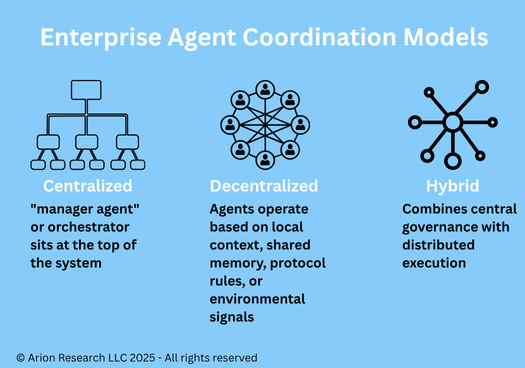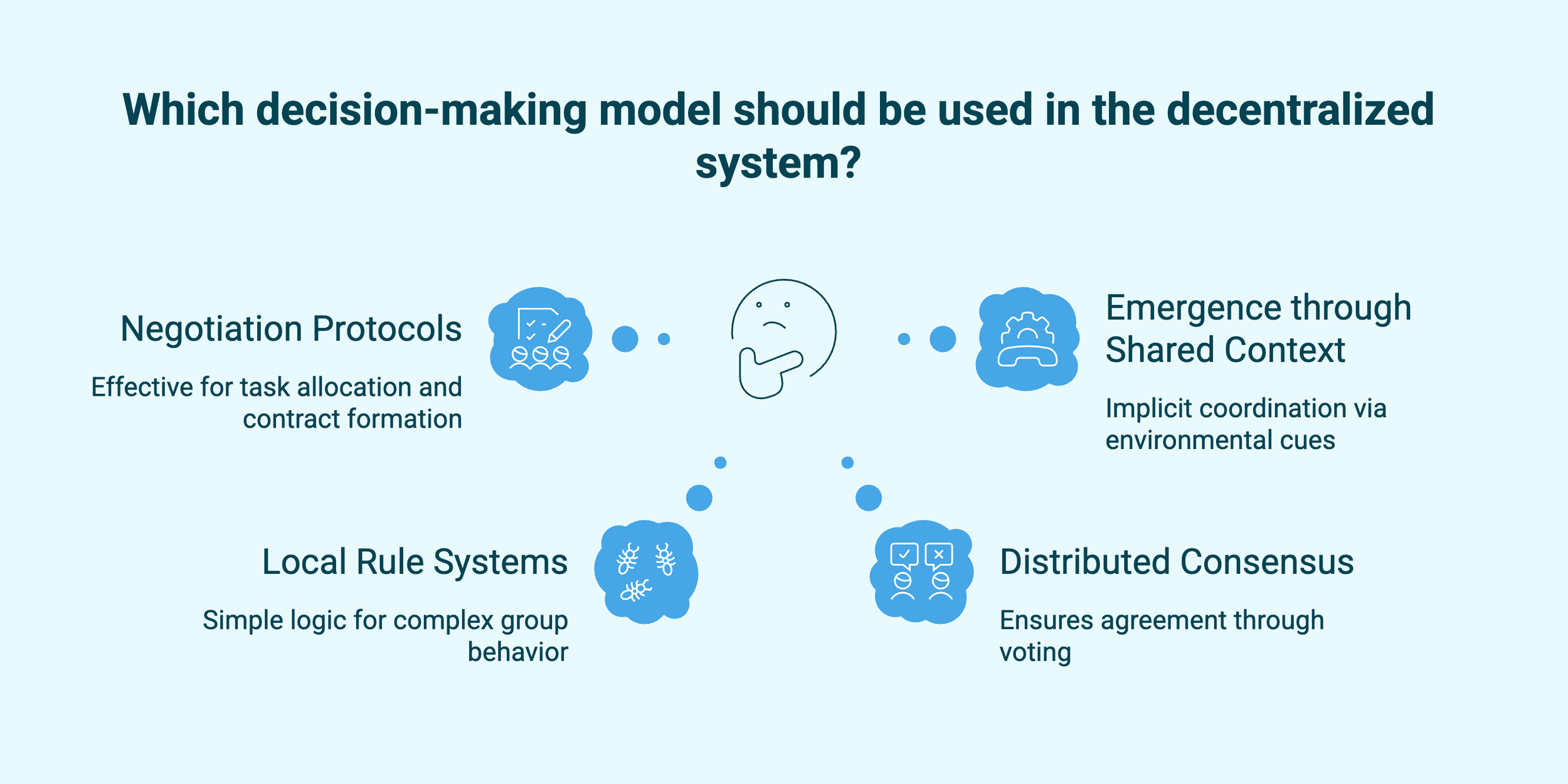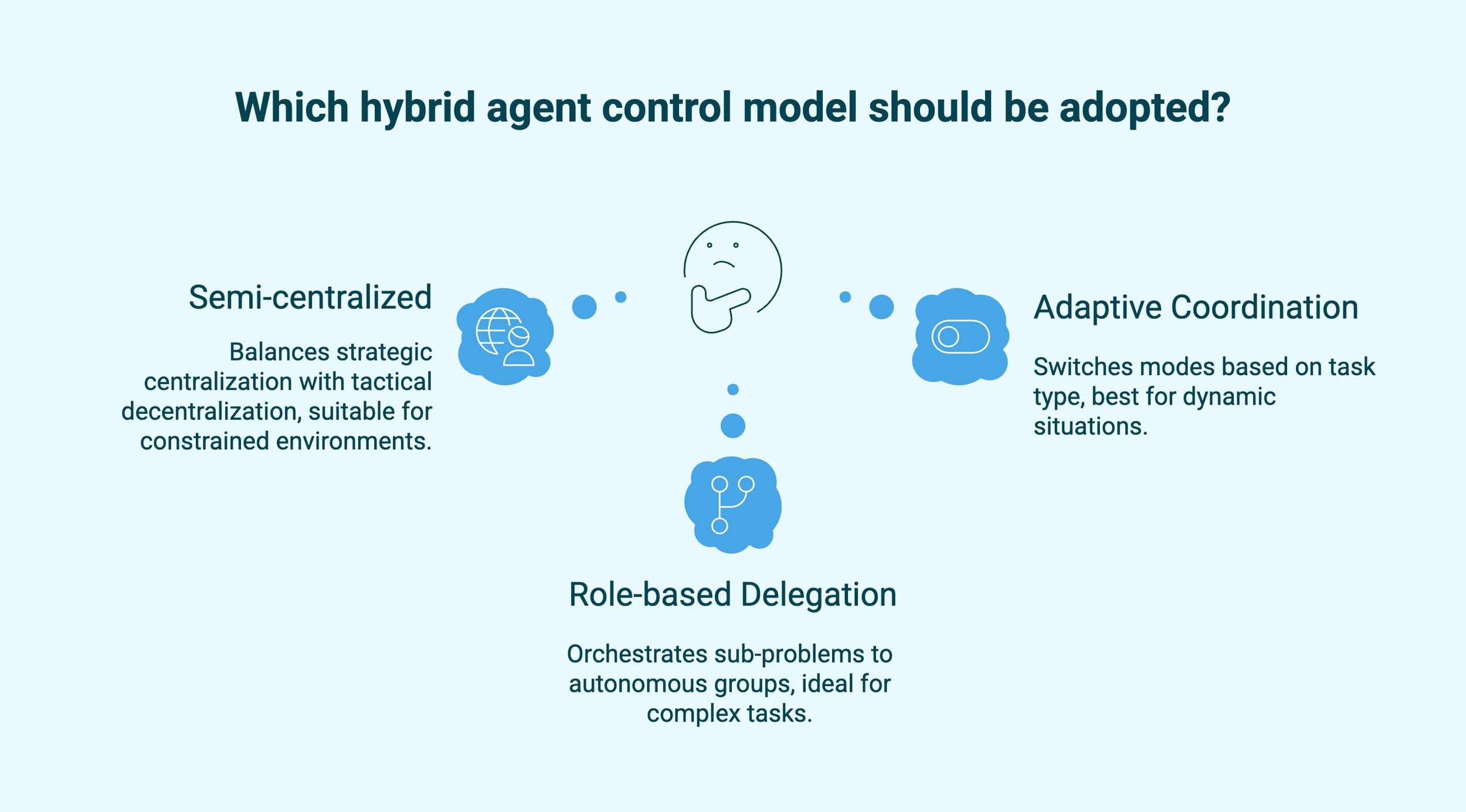Centralized vs Decentralized Agent Coordination: How Orchestration Choices Shape Autonomy, Resilience, and Emergent Behavior
As organizations move from assistive AI to building full digital workforces, a critical architectural question emerges: how should agents coordinate with each other? The decision between centralized orchestration and decentralized coordination isn't just a technical detail. It shapes everything from system resilience to innovation capacity, from operational predictability to adaptive problem-solving.
This choice sits at a tension point. Centralized coordination offers efficiency, visibility, and predictability. Decentralized coordination delivers resilience, adaptability, and emergent behavior. Most enterprises will land somewhere in between, but understanding these poles helps you design the right coordination architecture for your specific needs.
The Centralized Coordination Model
In centralized coordination, a "manager agent" or orchestrator sits at the top of the system. Think of it as the conductor of an orchestra or the foreman on a factory floor. Agents plug into a workflow or directed acyclic graph (DAG), with dependencies resolved by the orchestrator. Global state and task allocation flow through a single coordination point or small supervisory cluster.
The strengths are clear. Centralized systems deliver predictable execution, making safety controls easier to implement and maintain. Auditability becomes straightforward because every decision flows through observable checkpoints. When you have linear workflows where order matters, centralized coordination executes faster and with less overhead.
But the weaknesses matter too. Single points of failure create bottlenecks. When agent workloads spike, centralized systems struggle to scale. They handle novel or ambiguous tasks poorly because the orchestrator needs explicit rules for every scenario. Most critically, the orchestrator can become what I call the "forever bottleneck" for innovation. Every new capability, every experimental approach, every adaptive response must flow through that central control point.
Think of assembly lines, corporate hierarchies, or call center queue routing. These work beautifully for known, repeatable processes. They work less well when the environment demands continuous adaptation.
The Decentralized Coordination Model
Decentralized coordination flips the script. No central director exists. Instead, agents operate based on local context, shared memory, protocol rules, or environmental signals. Consensus and task allocation emerge dynamically through negotiation rather than top-down assignment.
I like to describe it as a potluck dinner: everyone brings something based on what they know and what they see others bringing, and somehow it becomes a functioning meal. No one person planned the whole thing, yet it works.
The strengths align with modern complexity. High resilience emerges because there's no central node to fail. Scalability improves dramatically because new agents can join without redesigning the entire system. Creativity and emergent problem-solving flourish because agents respond to local conditions rather than waiting for instructions. These systems handle dynamic environments where goals shift unpredictably.
The weaknesses require honest assessment. Guaranteeing consistency becomes harder when no central authority exists. Accountability diffuses across the network. Debugging a decentralized system feels more like tracking wildlife than following a flowchart. Performance can vary based on negotiation overhead, and sometimes agents spend more time coordinating than executing.
Real-world analogies include bee hives, open-source communities, and peer-to-peer networks. These systems excel at adaptation and resilience, even if they sacrifice some efficiency and predictability.
Decision-Making Models in Decentralized Systems
Decentralized coordination doesn't mean chaos. Several structured approaches enable effective agent collaboration without central control.
Negotiation protocols let agents bid on tasks, form contracts, or pass tokens that grant execution rights. Contract net protocols, originally developed for distributed AI research, remain surprisingly effective for enterprise agent networks.
Local rule systems operate on simple conditional logic: "If I see X, I do Y." These approaches draw inspiration from swarm robotics and ant colony optimization, where complex group behavior emerges from simple individual rules.
Distributed consensus mechanisms allow multiple agents to vote, rank, or validate outcomes. Lightweight quorum systems balance speed with coordination, while heavier consensus protocols ensure stronger guarantees when needed.
Emergence through shared context offers a particularly elegant approach. Vector databases or shared world models act as implicit coordination layers. Agents read and write environmental cues rather than communicating directly, creating a form of stigmergy where one agent's actions guide another's without explicit messages.
Hybrid Models: Where Most Enterprises Will Land
Pure centralization and pure decentralization both have their place, but most enterprise implementations will adopt hybrid approaches that combine central governance with distributed execution.
Semi-centralized architectures maintain a manager that sets constraints, budgets, or priorities, but agents negotiate execution details within those boundaries. Think of it as strategic centralization with tactical decentralization.
Role-based delegation takes this further. An orchestrator delegates entire sub-problems to decentralized agent groups, each handling their domain with autonomy while the orchestrator maintains overall coordination.
Adaptive coordination switches modes based on task type, system load, or risk level. Critical compliance workflows run through centralized orchestration, while creative problem-solving tasks run through decentralized collaboration.
The hybrid model dominates because it captures the best of both approaches: centralized governance for control, compliance, and visibility, paired with decentralized creativity for adaptation, resilience, and innovation. This balance matters more than theoretical purity.
Key Tradeoffs: Choosing the Right Model
Several critical tradeoffs shape your coordination architecture decision.
Predictability vs adaptability. Centralized systems deliver predictable outcomes through controlled execution paths. Decentralized systems adapt to novel situations through emergent responses. Choose based on whether your environment demands consistency or flexibility.
Control vs autonomy. Centralized approaches ensure compliance with policies, regulations, and standards. Decentralized approaches encourage innovation by giving agents freedom to experiment. The right balance depends on your risk tolerance and innovation appetite.
Efficiency vs resilience. Centralized coordination shines in stable workloads with predictable patterns. Decentralized coordination excels in chaotic environments where conditions change rapidly. Consider your operational volatility.
Cost structures differ too. Centralized systems are cheaper to monitor but create riskier single points of failure. Decentralized systems cost more to coordinate but deliver more robust operations. Calculate total cost of ownership, not just implementation cost.
Enterprise Use Cases: What Works Where
Different coordination models fit different enterprise contexts.
Centralized coordination works best for regulated workflows in finance, healthcare, and government. When you need clear chain-of-custody operations or must demonstrate compliance through audit trails, central orchestration provides the control and visibility regulators demand.
Decentralized coordination excels in research and development, where creativity matters more than predictability. Customer-facing automation at scale benefits from decentralized resilience because no single failure takes down the entire system. Complex multi-step problem-solving with uncertain inputs leverages the adaptive capacity of decentralized networks.
Hybrid coordination fits supply chain operations, customer service, sales operations, and IT support. Anywhere human and agent teams collaborate, hybrid models provide the structure humans expect while giving agents the autonomy they need to be effective.
The Future Trajectory
As agents grow more capable, central orchestration increasingly becomes a performance limiter rather than an enabler. Shared world models are emerging as "town squares" where agents coordinate through environmental cues rather than explicit commands. Hybrid governance is becoming the new standard, with clear escalation paths from decentralized execution to centralized oversight when needed.
Over time, decentralized agent networks will outperform traditional application-centric automation in environments that demand adaptation. The question isn't whether this shift will happen, but how quickly your organization positions itself to benefit from it.
Recommendations for Leaders
If you're designing coordination models for your digital workforce, start with these principles:
Begin with hybrid architectures. Set central guardrails for compliance, security, and policy enforcement, but allow distributed execution within those boundaries. Don't force everything through central control when local coordination works better.
Invest in protocol design, not just workflow design. Decentralized coordination requires clear rules of engagement between agents. Protocol design becomes as important as algorithm design.
Choose your decentralization battles. Identify specific environments where decentralized coordination provides measurable advantages: faster response times, better resilience, improved adaptation, or enhanced creativity. Don't decentralize for ideology; decentralize for outcomes.
Build monitoring that works in distributed systems. Traditional workflow monitoring assumes central visibility. Distributed systems require new approaches: state diffing, behavioral signature analysis, and emergent pattern detection.
Prepare for agent-to-agent collaboration. The future workforce includes agents that collaborate like teammates, not employees following a production line. Your coordination architecture should enable genuine collaboration, not just parallel task execution.
The Coordination Architecture Determines the Enterprise You Get
Centralized coordination builds a control machine: efficient, predictable, and auditable, but brittle in the face of change.
Decentralized coordination creates an adaptive ecosystem: resilient, creative, and flexible, but harder to govern and debug.
Hybrid coordination enables a resilient digital workplace that balances control with creativity, efficiency with adaptability, governance with innovation.
This architectural choice becomes a competitive differentiator. Companies that design coordination models matching their strategic needs will innovate faster with agentic AI. Those that default to familiar centralized patterns without considering alternatives will find their digital workforces constrained by coordination overhead.
The question isn't which model is "better." The question is which model fits your specific context, risk profile, and strategic objectives. Answer that question thoughtfully, and you'll build a digital workforce architecture that scales with your ambitions.



